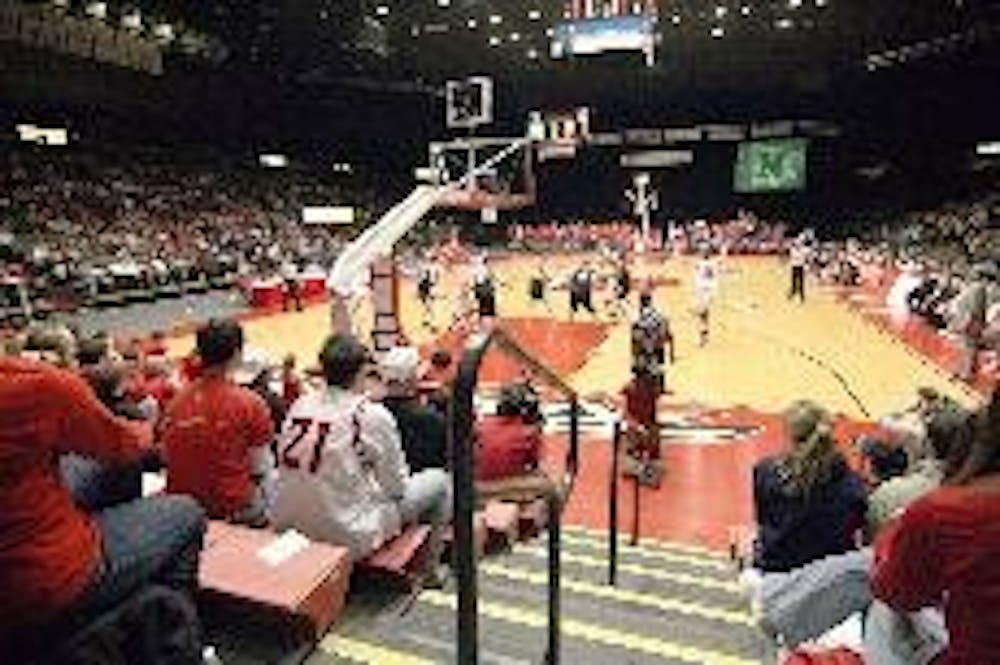
Attendance numbers at Miami men's basketball games have decreased 25 percent from 4,028 average fans per game last season to 3,104 this season. (Jeff Creech)
While one of President David Hodge's goals in his first year at Miami University is to make "Miami more Miami," and increase attendance at school athletic events, the current numbers have relatively decreased when compared with last year.
"I believe that improving school spirit is part of making the Miami experience even better," said Hodge via e-mail.
This semester's audience numbers at sporting events have varied across the three principle revenue-generating sports: basketball, football and ice hockey.
Men's basketball, a sport that has historically has seen a large audience, has seen its audience size decrease this year.
So far this season, the men's basketball team has attracted an average of 3,104 fans to each of their 10 home games according to the statistics available on MURedHawks.com, Miami's official Athletics Web site.
These numbers are down nearly 25 percent from last year's attendance record. During the 2005-06 season, Millett Hall averaged 4,028 fans per men's home game.
Likewise, the women's basketball team has also seen a drop in attendance this season. Their numbers have dropped from an average of 625 fans per game to 547.
Ice hockey, however, has seen an increase in attendance. The average hockey game this season attracts 3,422 fans on average, up from 2,514 last year. Attendance has grown this season largely due to the increased seating capacity of Steve Cady Arena, which can accommodate around 900 more people then the old Goggin.
Lastly, football saw virtually no change in attendance this season, as an average of 15,244 people attended each game in 2006 whereas 15,241 attended in 2005.
However according to Scott Renfro, director of game operations, attendance has been roughly the same for all sports for the past four to five years.
Enjoy what you're reading?
Signup for our newsletter
Yet Renfro also said that the Athletic Department has hired a new group sales director and a new marketing director to address attendance.
Through marketing to more high school and other youth organizations, the Athletic Department hopes that more of these organizations will attend games in large groups to help boost attendance.
Hodge said two of the ways he hopes to increase attendance numbers are by leading by example and getting the Oxford community more involved.
"(Mrs. Hodge and I) usually go to somewhere between one and three sporting events per week," Hodge said, via e-mail. "We have attended football and hockey the most, but have tried to get to as many different sports as possible."
Hodge also said hopes that Miami can become "more Miami" through creating a better sense of community in Oxford.
"We need to emphasize the sense of community more, work together with the Oxford community," Hodge said. " ... (We should) encourage everyone to participate more fully in events and activities on campus and in the surrounding area."
Miami students have different reactions to Hodge's goal as well as school spirit in general.
"I don't feel any school spirit," said senior Ryan Kremser. "I go to hockey games but I don't go to anything else. I won't see my friends there - they don't want to go either."
Jason Hale, vice president of Red Alert, the Miami student fan organization, said that finding a regular fan base of students is difficult.
"People come to the big games, but it's hard to see a consistent fan base for every game," Hale said.
Sophomore Eric Bracht said that he sees the problem stemming from a cycle of students feeding into one another's apathy.
"Because others don't care, no one else cares either," Bracht said. "No one grows up (as) a Miami fan."
Bracht also said that he sees competition from other Ohio universities as a main factor detracting from Miami's school spirit. He said he sees many students grow up watching Ohio State University football and basketball and expect that caliber of athletics, but that it is nearly impossible for Miami to compete with a school of Ohio State's size in terms of athletics.
Despite some sub par figures so far this year, Hale expressed optimism about Hodge's efforts.
"I think (Hodge will increase school spirit)," Hale said. "He's committed to creating a sense of awareness (about events at Miami). He's a good example to everyone because he's in attendance for a lot of games and other student productions."




